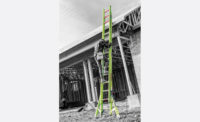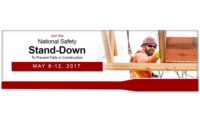Falls are among the most common causes of injury in the workplace. They can lead to severe injury, even death, but—with the proper precautions—they can be prevented. Without the proper precautions, same-level falls can occur during the simple act of walking, while falls to a lower level can occur from a ladder, scaffolding, roof, or other structure above the ground. National Institute for Occupational Safety and Health (NIOSH) investigators are taking a multifaceted approach to identify the risk factors for falls, and, ultimately, to develop preventive measures.
NIOSH Partners With the Ohio Bureau of Workers’ Compensation to Prevent Fall Injuries
As part of the NIOSH Center for Workers’ Compensation Studies, investigators are working with the Ohio Bureau of Workers’ Compensation to analyze over a decade of state workers’ compensation claims for falls to a lower level. The largest of four state-run workers’ compensation systems in the country, the bureau covers roughly two-thirds of Ohio workers. NIOSH Investigators estimate that the bureau’s data includes roughly 60,000 claims involving falls to a lower level from 2001 through 2011. The analysis will describe the annual number, rate, and severity of injuries from falls to a lower level that qualify for compensation among bureau claims. It will include worker demographics, injury circumstances, and work characteristics.
With these rich details, the investigators plan to highlight differences in injury rates between worker groups and understand whether employer participation in the grant program for safety intervention affects injury rates. The grant program is one of many programs, services, and resources that the bureau offers to employers for beginning safety interventions. To receive funding for the program, employers go through a competitive application process. After completing their data analysis, the investigators plan to submit their findings to a peer-reviewed journal and ultimately help Ohio employers prevent fall injuries.
Ladder Fall Injuries Higher Among Hispanics, Self-Employed, and Small Companies
To form a comprehensive picture of workers at greatest risk for ladder falls, NIOSH investigators analyzed three nationwide occupational injury surveillance systems. They presented their findings in a Centers for Disease Control and Prevention Morbidity and Mortality Weekly Report. They found that ladder fall injuries were significantly higher among Hispanics, self-employed workers, and those employed by small companies. They were also higher among men, older workers, and construction workers. To help prevent ladder fall injuries, NIOSH has developed a technologically innovative Ladder Safety App. Available in English or Spanish on the NIOSH website, the app provides user-friendly guides and interactive tools to prevent major causes of falls related to extension and stepladders.
Comprehensive Intervention Leads to Decline in Slips, Trips, and Falls
In three hospitals that began a fall-prevention plan developed by NIOSH and hospital staff, injuries from falls on the same level declined by more than half. These types of falls are commonly called “slips, trips, and falls.”
NIOSH investigators and hospital staff developed the prevention plan after analyzing 10 years of Workers’ Compensation data to identify the most common causes of fall-related injuries. Although different jobs may require different interventions, these results show that tailoring an intervention to a specific group, such as healthcare workers, can help decrease slips, trips, and falls.
The investigators have described their findings in a book chapter as part of an extensive, collaborative textbook, Fall Prevention and Protection: Principles, Guidelines, and Practices. The textbook will be published later this year.
More information is available:
Fall Injuries Prevention in the Workplace
NIOSH Center for Workers' Compensation Studies
Occupational Ladder Fall Injuries — United States, 2011
Evaluation of a Comprehensive Slip, Trip and Fall Prevention Program for Hospital Employees


